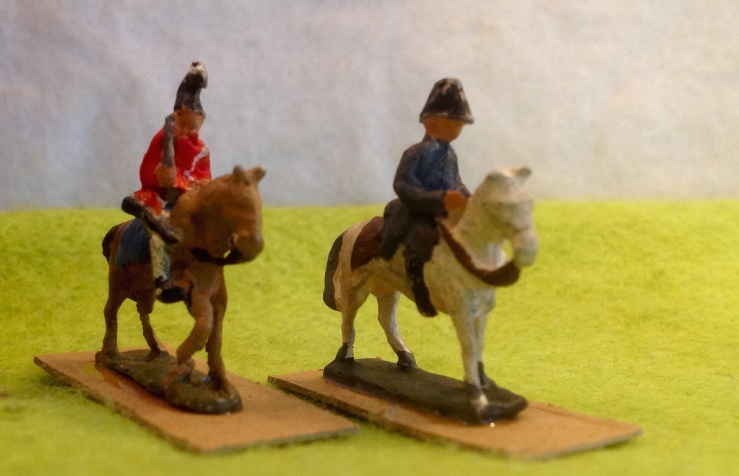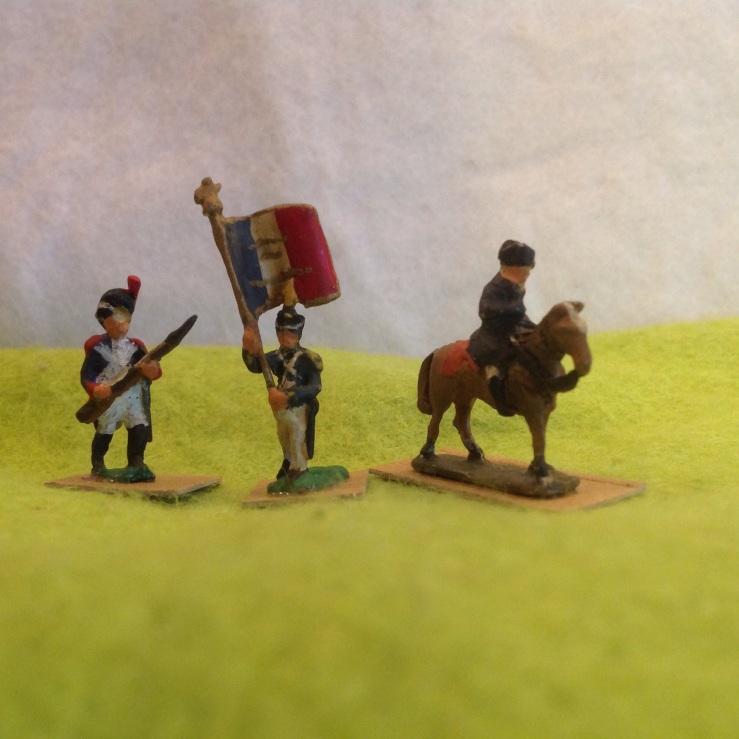
The Duke of Wellington dismissively observed to William Siborne, “You can as well write the history of a ball as of a battle.”
Siborne had asked for the Duke’s memories of the day amongst others to help accurately construct his diorama model of Waterloo, which now rests in the National Army Museum. Well worth visiting in its new restoration.
A short account of this model can be found in Harry Pearson’s autobiography Achtung Schweinhund! featured as a warning against investing too much money in toy soldiers over the years (whoops!); a longer account can be found in a book by Miniature Wargames games writer and historian Peter Hofschroer’s cleverly titled Wellington’s Smallest Victory (Faber, 2004).
Having just finished one longish games write up (the longer as sections of it wiped once), I find this Wellington quote interesting as the possible difference between ‘history’ and ‘fiction’ – the point of view (or continuously confusing shifting point of view if you are Virginia Woolf) that it’s written from. Is it an impersonal lab report? Is it the skeleton plot of historical fiction? A confused blend of both?
As I write up recent tabletop skirmishes, I have been thinking about the links between fiction and gaming. Writing up games reports of past battles, I am reminded of Wellington’s (dismissive?) quote. Commonly many games bloggers feel that their thrilling accounts can appear somewhat tedious for other readers.
Some of the more interesting ones (insert your favourites here) go further than a blow-by-blow account; they reflect on the rule changes or improvisations that crop up, being a form of playtesting.
Great photographs of figures and terrain also help, whilst some like the Wargames Hermit now have direction arrows in photos to help you follow the action more clearly.
Such blog write ups become demonstration games for rules, very much in the spirit of H.G. Wells in “The Battle of Hook’s Farm” section of Little Wars or Donald Featherstone’s classic battles in his 1962 War Games. Others like Robert Louis Stevenson’s Yallobelly Times newspaper style battle reports take on a life of their own.
Games reports also hopefully share and remember the escapist “joy and forgetfulness” that gaming brings with itself.
The full Wellington quotes from the ever reliable WikiQuotes are:
“The history of a battle, is not unlike the history of a ball. Some individuals may recollect all the little events of which the great result is the battle won or lost, but no individual can recollect the order in which, or the exact moment at which, they occurred, which makes all the difference as to their value or importance.” Letter to John Croker (8 August 1815), as quoted in The History of England from the Ascension of James II (1848) by Macaulay, Volume 1 Chapter 5; and in The Waterloo Letters (1891) edited by H. T. Siborne.
“Just to show you how little reliance can be placed even on what are supposed the best accounts of a battle, I mention that there are some circumstances mentioned in General —’s account which did not occur as he relates them. It is impossible to say when each important occurrence took place, or in what order.” Wellington’s papers (17 August 1815), as quoted in The History of England from the Ascension of James II (1848) by Thomas Babington Macaulay.
Jane Austen (1775 – 1817), being Wellington’s shorter lived contemporary (Wellington lived 1769 – 1852), would have something to say about the value of writing the history of a ball, from many shifting viewpoints and many carefully observed details, especially if you want to point up character. The famous Brussels ball on the eve of Waterloo also features in Thackeray’s Vanity Fair (1847/8).
There is an interesting social history book In These Times by Jenny Uglow on the Georgian / Regency background of Waterloo and the Napoleonic Wars https://www.theguardian.com/books/2014/nov/06/in-these-times-living-in-britain-through-napoleons-wars-1793-1815-jenny-uglow-review
Inside Peter Hofschroer’s book (page 178 ) is another version of the “writing a battle and ball” quote, when Wellington talked about his view the accuracy of Siborne’s Waterloo model (quoted by Hofschroer from Sir John R. Mowbray, “Seventy Years at Westminster”, Blackwood’s Edinburgh Magazine July 1898):
“… If you want to know my opinion it’s all farce, fudge! They went to one gentleman and said “What did you do?” “I did so and so.” To another, “What did you do?” “I did such and such a thing.” One did it at ten and another at twelve, and they have mixed up the whole. The fact is, a battle is like a ball; they kept footing it all the day through.”
And to another, Francis Egerton in 1845 (Hofschroer, page 179):
” … of which beautiful work he [Siborne] has made a scene of confusion, such as would be a drawing or representation in one view of all the scenes and acts of a play in five acts.”
Wellington in his old age in his actions towards Siborne does not come out of this account by Peter Hofschroer too well.
And now for some gratuitous photographs of the few Peter Laing 15mm Waterloo / Napoleonic figures I bought as a young teenager, still much as I painted them 30+ years ago. They are due for rebasing and some odd retouches of paint soon. I wished I had bought more and have since acquired a few additional ones for future small skirmish games.





Posted by Mr MIN, Man of TIN, 25 August 2016.



Just stumbled across this site which has brought back so many memories. I was sparked by uncovering a box of Peter Laing Franco Prussian War soldiers that have been hiding in the garage for some 40+ years. I used to have a large collection of PL colonial troops, but I mislaid them years ago and have been unable to find them. Love this site and will follow from now on.
Bob
LikeLike
Bob
Welcome! Many thanks for your comments on the blog and for your Peter Laing memories. I will feature the few PL colonials I have in a game soon, I have a few more to paint first.
Hopefully your PL colonial troops will emerge from a shelf one day as sadly you can’t buy them new any more.
Peter has retired, the whereabouts of the moulds are currently unknown. There is a good second hand trade on EBay and a good blog presence of Peter Laing figures such as Bob Cordery’s Wargaming Miscellany and John Patriquin’s Wargames Hermit site amongst others. There is also now a small circle of Peter Laing enthusiasts headed up by Ian Dury (find him on Google+); Ian also likes Peter Laing Franco Prussians. I hope you enjoy my future Man of TIN blog posts, I am busy painting a scratch platoon level skirmish game of Peter Laing’s WW2 figures.
Happy Gaming!
Mark, Mr MIN, Man of TIN.
LikeLike
I shall keep my eyes open for them on eBay – would love to find some Napoleonics and maybe replace those long lost colonials. In my recently discovered box there is a solitary sudanese tribesman and a couple of Zulus.
Bob
LikeLike
Mark – I love those Napoleonics – I have quite a few myself – but very few are used as intended!
Wellington I use as a Crimean British general and FP War French general
Napoleon with his hat re-shaped is Moltke – or in a different paint finish, a Russian Crimean general
British Household Cavalry double as Danish Dragoons for 1864 and as Bavarian Cuirassiers for both 1866 and the FP War
Finally, I have recently converted some British infantry – with a minor re-shaping of the shako – to Hanoverians for 1866 (if you look at the Knoetel prints for the period, they are wearing equipment identical to our late Napoleonic equivalent)
Prussian Landwehr act as their equivalents for the FP war
Prussian Infantry, with the shako cut down and hammered slightly flat are their later equivalents for 1866 and the FP war in schirmutze (flat caps)
I do have some ‘French in Egypt’ courtesy of my old friend Barry Carter – who introduced me to Peter Laing figures all those years ago – plus some opposing British infantry in top hats
Bob – if you can bear to part with those FP War Laings, please let me know! I may be able to sort some Colonials in exchange…
LikeLike
Hi Ian – I will never use the FP figures, so happy to exchange. Let me know what you have in mind. I too really like those Napoleonics, all very charming.
Bob
LikeLike
Bob
So glad that these brave and tiny but dusty men will see action again soon, albeit in someone else’s command. I hope you find your old colonials or receive some in exchange. Your surviving couple of colonial Peter Laing figures (a couple of Zulus and solitary Sudanese) should of course be highly promoted and become like the veteran, long lost then refound “Little Audie” figure out of Harry Pearson’s lovely book Achtung Schweinhund. Everybody must have their own such Little Audie figure …
Mark (Man of TIN)
LikeLike
Bob – I am sure we can sort something – I have loads of Zulus for one thing.
My e-mail address is ian dot dury at Hotmail dot co dot uk
LikeLike
I like the sound of your (paint) conversions. The Crimean and Napoleonic ranges overlap quite well – in fact I think my few Napoleonic Highlanders are from Peter’s Crimean Range under his nicely phrased “possible dual use items”. Part of the joy of Peter not over detailing his figures is how flexible or adaptable they are.
Mark (Man of TIN blog)
LikeLike
Yes – I forgot to mention the Highlanders, though I actually use them for the intended purpose!
I will take some pictures to send you – but may be next week as we are busy this weekend
LikeLike
Re the “Little Audie” figure – I have a complete unit of my FP War Prussian Army (actually Crimean Russians in helmets masquerading as Prussians in Greatcoats!) that take that role. The 2nd Battalion of the 1st Silesian Grenadiers have a parade streamer to their standard, courtesy of an amazingly courageous defence of a farmhouse by a single company against two Austrian battalions during the crossing of the River Main in 1866.
If my old friend and former Austrian opponent, David Williams, reads this, he will remember (and please get in touch – we haven’t spoken for years!)
I will put some pictures and the full story on my Peter Laing Google+ collection:
https://plus.google.com/u/0/collection/os0rZB
(You can see the Silesian Grenadiers with the pink standard in one of the ‘Potsdam Parade’ pictures in that Collection – but the battalion with the streamer is in the second rank)
LikeLike
An impressive parade. I really like the idea of battle and campaign honours as after all it is the regiment and not the men (campaign medals aside) who continue and carry the tradition on.
LikeLike
Thank you, I am glad you liked. My only regret from that game is that I was a hurry to pack up afterwards, so I didn’t put the five figures that made up the company to one said. If I had, they would have all got their own iron crosses. (I was young enough to be able to paint like that then!)
LikeLike